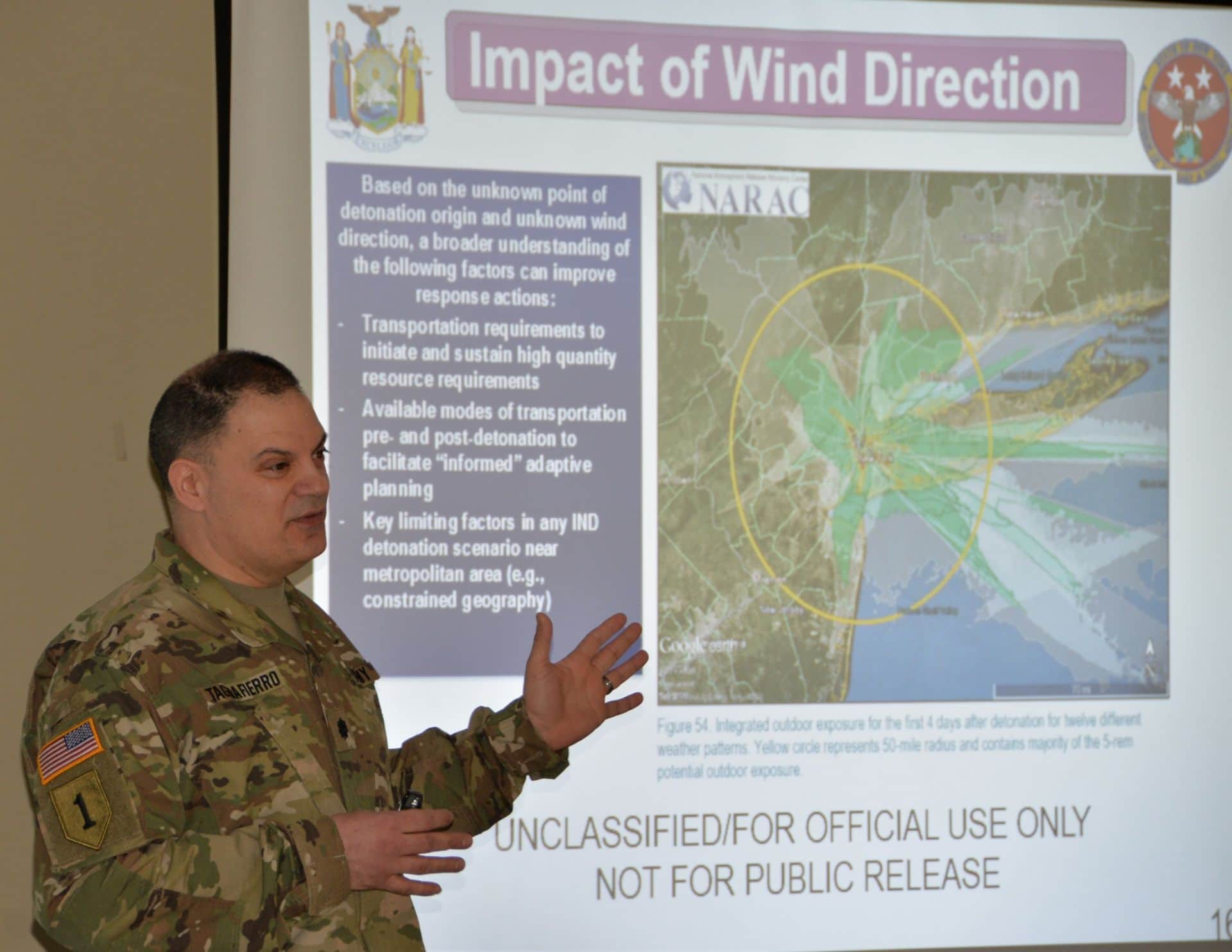It’s just after 10 a.m. on April 24, 2017, when the New York 1 cable TV news feed in the New York National Guard Joint Operations Center here goes dark.
Gabreski Air National Guard Base at the eastern tip of Long Island calls in, reporting a bright flash in the direction of New York City. Camp Smith in the Hudson Valley calls and says they see a flash to the south.
Phone calls to New York City don’t go through.
A nuclear device has detonated on Manhattan and the New York National Guard has to begin reacting. What happens next?
Fifty New York National Guard leaders and planners spent Thursday thinking about the unthinkable during a day-long table top exercise that included representatives from National Guard Bureau and Northern Command.
“An IND [improvised nuclear device] goes off in New York City; a million people killed right up front, and six million people needing shelter and food and medical help for at least four days in the most complicated megalopolis in the world. This is graduate level stuff,” said New York Air National Guard Brig. Gen. Timothy LaBarge, director of staff for the New York Air National Guard and the commander for the drill.
The table top exercise, LaBarge said, was designed as a rehearsal for New York National Guard’s participation in the Ardent Sentry 17 domestic response exercise that kicks off on April 24.
Ardent Sentry is an annual North American Aerospace Defense and U.S. Northern Command exercise focused on defense support to civil authorities with military capabilities. Exercise scenarios have included hurricanes, tornadoes damaging a nuclear weapons storage site, and massive earthquakes.
This year the scenario will revolve around a nuclear detonation in Manhattan. City, state, federal and military officials will work through the steps in responding to that kind of disaster.
Because he has been designated as the dual-status commander for the New York National Guard during the exercise, he wanted to think through the steps involved in responding beforehand, LaBarge explained.
A dual-status commander is a National Guard officer who is authorized to command both National Guard military forces — under the command of the governor–and federal military forces–under the command of the president.
Dual-status commanders can direct both federal active-duty forces and state National Guard forces in response to domestic incidents. The concept is intended to foster greater cooperation among federal and state assets during a disaster. The New York National Guard stood up a dual status commander in 2012 during the state response to Superstorm Sandy.
“We are going to walk ourselves through this, so it is not all brand new to us”, LaBarge told the exercise participants.
“We want to work out the moving parts. What forces are available to us? What about New Jersey and Massachusetts and New Hampshire?” he added. “It’s complicated.”
The exercise required participants to explain the steps their staff sections or commands would take, as the New York National Guard responded to a nuclear incident, beginning with the initial response.
Not all issues got resolved, but the opportunity to talk through the steps and identify issues ahead of time was incredibly valuable, said Brig. Gen. Patrick Center, the Director of Joint Staff for the New York National Guard.
The drill began with the device detonating, and moved through the first steps in response to the notional emergency.
The headquarters of the Troy, New York, based 42nd Infantry Division, which is designated to command the Federal Emergency Management Agency Region II Homeland Response Force, would begin calling in Guard Soldiers and standing up a command post with full-time officers and noncommissioned officers.
The 24th Civil Support Team (CST), which is trained to evaluate nuclear, chemical, radiological, and biological attacks would shelter in place at their headquarters at Fort Hamilton in Brooklyn as a fallout plume passed overhead and wait for further orders. Their counterparts in the 2nd CST based at Stratton Air National Guard Base outside Schenectady, New York, would begin moving to an assembly area while the New Hampshire CST also started moving based on prior agreements.
Guard aviators would report to the New York State Emergency Management Office and begin coordinating for military and civilian agency air operations. The personnel section would begin the process of putting Soldiers and Airmen on State Active Duty, while the logistic section would lay the groundwork for moving the supplies needed to sustain thousands of Guard troops in action, coordinate convoy routes, and figure out where replacement hazmat suits and MREs would come from.
Much of the discussion hinged around legal issues of command and control and when Guard troops might move from state active duty status — with the state paying their salaries and buying supplies — to a federally funded response status in which the governor would still command the New York National Guard, but the federal government picked up the tab.
A team from Northern Command explained how an active duty team would move to New York to assist LaBarge and help coordinate the response.
Communications, the use of remotely piloted aircraft, and how Guard troops would interact with New York City first responders and federal troops were also hashed out.
The value of these kinds of discussions is that it lets planners and leaders identify potential issues ahead of time and make a workable plan, said Ron Hessdoerfer, a member of the Northern Command training and exercise and operations branch.
“A plan that is never exercised isn’t really a plan. It is just a book on the shelf,” Hessdoerfer said.
The critical thing in an actual emergency, LaBarge emphasized as the exercise concluded, would be to forget about egos and unit roles and concentrate on savings lives.
“As long as we resolve to do that, we will figure it out,” he said.










